Submitted:
18 July 2023
Posted:
19 July 2023
You are already at the latest version
Abstract
Keywords:
1. Introduction
2. Materials and Methods
2.1. Tissue Preparation and Chemical Degradation
2.2. Mechanical Testing
2.2.1. Ring Tensile Testing
2.2.2. Inflation-Extension Testing
2.3. Histological Processing and Histomorphometric Quantification
2.4. Statistical Analysis
3. Results
3.1. Impact of Elastase Treatment on Aortic Elastin Structure and Content
3.2. Impact of Elastase Treatment on Aortic Ring Morphology
3.3. Impact of Elastase Incubation on the Tensile Properties of Aortic Rings
3.4. Ex Vivo Porcine Model with Localised Elastin Degradation
3.5. Inflation-Extension of the Localised Elastin-Degradation ex Vivo Aneurysm Model
4. Discussion
5. Conclusions
Supplementary Materials
Author Contributions
Funding
Institutional Review Board Statement
Informed Consent Statement
Data Availability Statement
Acknowledgments
Conflicts of Interest
Abbreviations
References
- Tse, H.-F.; Lip, G.Y.; Coats, A.J.S. Cardiology (Oxford Desk Reference); Oxford University Press: Oxford, UK, 2011. [Google Scholar]
- Li, X.; Zhao, G.; Zhang, J.; Duan, Z.; Xin, S. Prevalence and Trends of the Abdominal Aortic Aneurysms Epidemic in General Population - A Meta-Analysis. PLOS ONE 2013, 8, e81260. [Google Scholar] [CrossRef]
- Wei, L.; Bu, X.; Wang, X.; Liu, J.; Ma, A.; Wang, T. Global Burden of Aortic Aneurysm and Attributable Risk Factors from 1990 to 2017. Glob Heart 2021, 16, 35–35. [Google Scholar] [CrossRef]
- Dillavou, E.D.; Muluk, S.C.; Makaroun, M.S. Improving aneurysm-related outcomes: nationwide benefits of endovascular repair. J Vasc Surg 2006, 43, 446–451. [Google Scholar] [CrossRef] [PubMed]
- Daye, D.; Walker, T.G. Complications of endovascular aneurysm repair of the thoracic and abdominal aorta: evaluation and management. Cardiovasc Diagn Ther 2018, 8, S138–s156. [Google Scholar] [CrossRef] [PubMed]
- Roach, M.R.; Burton, A.C. The reason for the shape of the distensibility curves of arteries. Can J Biochem Physiol 1957, 35, 681–690. [Google Scholar] [CrossRef]
- Iliopoulos, D.C.; Kritharis, E.P.; Giagini, A.T.; Papadodima, S.A.; Sokolis, D.P. Ascending thoracic aortic aneurysms are associated with compositional remodeling and vessel stiffening but not weakening in age-matched subjects. J Thorac Cardiovasc Surg 2009, 137, 101–109. [Google Scholar] [CrossRef] [PubMed]
- He, C.M.; Roach, M.R. The composition and mechanical properties of abdominal aortic aneurysms. J Vasc Surg 1994, 20, 6–13. [Google Scholar] [CrossRef] [PubMed]
- Cebull, H.L.; Rayz, V.L.; Goergen, C.J. Recent Advances in Biomechanical Characterization of Thoracic Aortic Aneurysms. Front Cardiovasc Med 2020, 7, 75. [Google Scholar] [CrossRef] [PubMed]
- Marconi, S.; Lanzarone, E.; van Bogerijen, G.H.W.; Conti, M.; Secchi, F.; Trimarchi, S.; Auricchio, F. A compliant aortic model for in vitro simulations: Design and manufacturing process. Med Eng Phys 2018, 59, 21–29. [Google Scholar] [CrossRef]
- Holzapfel, G.A.; Weizsäcker, H.W. Biomechanical behavior of the arterial wall and its numerical characterization. Computers in Biology and Medicine 1998, 28, 377–392. [Google Scholar] [CrossRef]
- Chow, M.J.; Turcotte, R.; Lin, C.P.; Zhang, Y. Arterial extracellular matrix: a mechanobiological study of the contributions and interactions of elastin and collagen. Biophys J 2014, 106, 2684–2692. [Google Scholar] [CrossRef] [PubMed]
- Vande Geest, J.P.; Sacks, M.S.; Vorp, D.A. The effects of aneurysm on the biaxial mechanical behavior of human abdominal aorta. Journal of Biomechanics 2006, 39, 1324–1334. [Google Scholar] [CrossRef] [PubMed]
- Sokolis, D.P.; Kritharis, E.P.; Giagini, A.T.; Lampropoulos, K.M.; Papadodima, S.A.; Iliopoulos, D.C. Biomechanical response of ascending thoracic aortic aneurysms: association with structural remodelling. Computer Methods in Biomechanics and Biomedical Engineering 2012, 15, 231–248. [Google Scholar] [CrossRef] [PubMed]
- Yoffe, B.; Vaysbeyn, I.; Urin, Y.; Waysbeyn, I.; Zubkova, O.; Chernyavskiy, V.; Ben-Dor, D. Experimental Study of a Novel Suture-less Aortic Anastomotic Device. European Journal of Vascular and Endovascular Surgery 2007, 34, 79–86. [Google Scholar] [CrossRef]
- Giannatsis, J.; Dedoussis, V. Additive fabrication technologies applied to medicine and health care: a review. The International Journal of Advanced Manufacturing Technology 2009, 40, 116–127. [Google Scholar] [CrossRef]
- de Beaufort, H.W.L.; Conti, M.; Kamman, A.V.; Nauta, F.J.H.; Lanzarone, E.; Moll, F.L.; van Herwaarden, J.A.; Auricchio, F.; Trimarchi, S. Stent-Graft Deployment Increases Aortic Stiffness in an Ex Vivo Porcine Model. Ann Vasc Surg 2017, 43, 302–308. [Google Scholar] [CrossRef]
- Nauta, F.J.H.; de Beaufort, H.W.L.; Conti, M.; Marconi, S.; Kamman, A.V.; Ferrara, A.; van Herwaarden, J.A.; Moll, F.L.; Auricchio, F.; Trimarchi, S. Impact of thoracic endovascular aortic repair on radial strain in an ex vivo porcine model. Eur J Cardiothorac Surg 2017, 51, 783–789. [Google Scholar] [CrossRef] [PubMed]
- Nauta, F.J.; Conti, M.; Marconi, S.; Kamman, A.V.; Alaimo, G.; Morganti, S.; Ferrara, A.; van Herwaarden, J.A.; Moll, F.L.; Auricchio, F.; et al. An experimental investigation of the impact of thoracic endovascular aortic repair on longitudinal strain. Eur J Cardiothorac Surg 2016, 50, 955–961. [Google Scholar] [CrossRef]
- de Beaufort, H.W.L.; Coda, M.; Conti, M.; van Bakel, T.M.J.; Nauta, F.J.H.; Lanzarone, E.; Moll, F.L.; van Herwaarden, J.A.; Auricchio, F.; Trimarchi, S. Changes in aortic pulse wave velocity of four thoracic aortic stent grafts in an ex vivo porcine model. PLOS ONE 2017, 12, e0186080. [Google Scholar] [CrossRef]
- de Beaufort, H.W.L.; Ferrara, A.; Conti, M.; Moll, F.L.; van Herwaarden, J.A.; Figueroa, C.A.; Bismuth, J.; Auricchio, F.; Trimarchi, S. Comparative Analysis of Porcine and Human Thoracic Aortic Stiffness. Eur J Vasc Endovasc Surg 2018, 55, 560–566. [Google Scholar] [CrossRef]
- Hoefer, A.C.; Bouchagiar, J.; Goltz, J.P.; Horn, M.; Matthiensen, S.; Matysiak, F.; Stahlberg, E.; Kleemann, M. Development of an Endovascular Training Model for Simulation of Evar Procedures Using 3D Rapid Prototyping for the Production of Exchangeable Patient Specific Anatomic Models. European Journal of Vascular and Endovascular Surgery 2019, 58, e290–e292. [Google Scholar] [CrossRef]
- Biglino, G.; Verschueren, P.; Zegels, R.; Taylor, A.M.; Schievano, S. Rapid prototyping compliant arterial phantoms for in-vitro studies and device testing. Journal of Cardiovascular Magnetic Resonance 2013, 15, 2. [Google Scholar] [CrossRef] [PubMed]
- Doyle, B.J.; Morris, L.G.; Callanan, A.; Kelly, P.; Vorp, D.A.; McGloughlin, T.M. 3D Reconstruction and Manufacture of Real Abdominal Aortic Aneurysms: From CT Scan to Silicone Model. Journal of Biomechanical Engineering 2008, 130. [Google Scholar] [CrossRef] [PubMed]
- Sulaiman, A.; Boussel, L.; Taconnet, F.; Serfaty, J.M.; Alsaid, H.; Attia, C.; Huet, L.; Douek, P. In vitro non-rigid life-size model of aortic arch aneurysm for endovascular prosthesis assessment. European Journal of Cardio-Thoracic Surgery 2008, 33, 53–57. [Google Scholar] [CrossRef]
- Bianco, R.; Di Gregoli, K.; Caputo, M.; George, S.J.; Johnson, J.L. A Protocol for a Novel Human Ex Vivo Model of Aneurysm. STAR Protocols 2020, 1, 100108. [Google Scholar] [CrossRef]
- Bianco, R.; Di Gregoli, K.; Caputo, M.; Zakkar, M.; George, S.; Johnson, J. Development and characterisation of a human ex-vivo model of aneurysm. Atherosclerosis 2018, 275, e144–e145. [Google Scholar] [CrossRef]
- Meekel, J.P.; Groeneveld, M.E.; Bogunovic, N.; Keekstra, N.; Musters, R.J.P.; Zandieh-Doulabi, B.; Pals, G.; Micha, D.; Niessen, H.W.M.; Wiersema, A.M.; et al. An in vitro method to keep human aortic tissue sections functionally and structurally intact. Scientific Reports 2018, 8, 8094. [Google Scholar] [CrossRef]
- Dobrin, P.B.; Mrkvicka, R. Failure of Elastin or Collagen as Possible Critical Connective Tissue Alterations Underlying Aneurysmal Dilatation. Cardiovascular Surgery 1994, 2, 484–488. [Google Scholar] [CrossRef]
- Kratzberg, J.A.; Walker, P.J.; Rikkers, E.; Raghavan, M.L. The effect of proteolytic treatment on plastic deformation of porcine aortic tissue. Journal of the Mechanical Behavior of Biomedical Materials 2009, 2, 65–72. [Google Scholar] [CrossRef]
- Chow, M.J.; Mondonedo, J.R.; Johnson, V.M.; Zhang, Y. Progressive structural and biomechanical changes in elastin degraded aorta. Biomech Model Mechanobiol 2013, 12, 361–372. [Google Scholar] [CrossRef]
- Lane, B.A.; Cardoza, R.J.; Lessner, S.M.; Vyavahare, N.R.; Sutton, M.A.; Eberth, J.F. Full-field strain mapping of healthy and pathological mouse aortas using stereo digital image correlation. Journal of the Mechanical Behavior of Biomedical Materials 2023, 141, 105745. [Google Scholar] [CrossRef] [PubMed]
- Miskolczi, L.; Guterman, L.R.; Flaherty, J.D.; Szikora, I.; Hopkins, L.N. Rapid saccular aneurysm induction by elastase application in vitro. Neurosurgery 1997, 41, 220–228. [Google Scholar] [CrossRef] [PubMed]
- Patelis, N.; Moris, D.; Schizas, D.; Damaskos, C.; Perrea, D.; Bakoyiannis, C.; Liakakos, T.; Georgopoulos, S. Animal models in the research of abdominal aortic aneurysms development. Physiol Res 2017, 66, 899–915. [Google Scholar] [CrossRef] [PubMed]
- Daugherty, A.; Cassis, L.A. Mouse models of abdominal aortic aneurysms. Arterioscler Thromb Vasc Biol 2004, 24, 429–434. [Google Scholar] [CrossRef]
- Tornifoglio, B.; Stone, A.J.; Johnston, R.D.; Shahid, S.S.; Kerskens, C.; Lally, C. Diffusion tensor imaging and arterial tissue: establishing the influence of arterial tissue microstructure on fractional anisotropy, mean diffusivity and tractography. Scientific Reports 2020, 10, 20718. [Google Scholar] [CrossRef]
- Schneider, C.A.; Rasband, W.S.; Eliceiri, K.W. NIH Image to ImageJ: 25 years of image analysis. Nature Methods 2012, 9, 671–675. [Google Scholar] [CrossRef]
- Macrae, R.A.; Miller, K.; Doyle, B.J. Methods in Mechanical Testing of Arterial Tissue: A Review. Strain 2016, 52, 380–399. [Google Scholar] [CrossRef]
- Campbell, E.M.; Cahill, P.A.; Lally, C. Investigation of a small-diameter decellularised artery as a potential scaffold for vascular tissue engineering; biomechanical evaluation and preliminary cell seeding. J Mech Behav Biomed Mater 2012, 14, 130–142. [Google Scholar] [CrossRef]
- Kim, J.; Baek, S. Circumferential variations of mechanical behavior of the porcine thoracic aorta during the inflation test. J Biomech 2011, 44, 1941–1947. [Google Scholar] [CrossRef]
- Horný, L.; Žitný, R.; Chlup, H.; Hana, M. Identification of the material parameters of an aortic wall. Bulletin of Applied Mechanics 2007. [Google Scholar]
- Ruifrok, A.C.; Johnston, D.A. Quantification of histochemical staining by color deconvolution. Anal Quant Cytol Histol 2001, 23, 291–299. [Google Scholar] [PubMed]
- Fonck, E.; Prod'hom, G.; Roy, S.; Augsburger, L.; Rüfenacht, D.A.; Stergiopulos, N. Effect of elastin degradation on carotid wall mechanics as assessed by a constituent-based biomechanical model. Am J Physiol Heart Circ Physiol 2007, 292, H2754–2763. [Google Scholar] [CrossRef] [PubMed]
- Cox, R.H. Passive mechanics and connective tissue composition of canine arteries. Am J Physiol 1978, 234, H533–541. [Google Scholar] [CrossRef]
- Wang, R.; Brewster, L.P.; Gleason, R.L. In-situ characterization of the uncrimping process of arterial collagen fibers using two-photon confocal microscopy and digital image correlation. Journal of Biomechanics 2013, 46, 2726–2729. [Google Scholar] [CrossRef]
- Avanzini, A.; Battini, D.; Bagozzi, L.; Bisleri, G. Biomechanical evaluation of ascending aortic aneurysms. BioMed research international 2014, 2014, 820385–820385. [Google Scholar] [CrossRef] [PubMed]
- Vorp, D.A.; Schiro, B.J.; Ehrlich, M.P.; Juvonen, T.S.; Ergin, M.A.; Griffith, B.P. Effect of aneurysm on the tensile strength and biomechanical behavior of the ascending thoracic aorta. Ann Thorac Surg 2003, 75, 1210–1214. [Google Scholar] [CrossRef]
- Bossone, E.; Eagle, K.A. Epidemiology and management of aortic disease: aortic aneurysms and acute aortic syndromes. Nat Rev Cardiol 2021, 18, 331–348. [Google Scholar] [CrossRef]
- Isselbacher, E.M. Thoracic and Abdominal Aortic Aneurysms. Circulation 2005, 111, 816–828. [Google Scholar] [CrossRef]
- Jesudason, R.; Black, L.; Majumdar, A.; Stone, P.; Suki, B. Differential effects of static and cyclic stretching during elastase digestion on the mechanical properties of extracellular matrices. J Appl Physiol (1985) 2007, 103, 803–811. [Google Scholar] [CrossRef]
- Momtahan, N.; Poornejad, N.; Struk, J.A.; Castleton, A.A.; Herrod, B.J.; Vance, B.R.; Eatough, J.P.; Roeder, B.L.; Reynolds, P.R.; Cook, A.D. Automation of Pressure Control Improves Whole Porcine Heart Decellularization. Tissue Engineering Part C: Methods 2015, 21, 1148–1161. [Google Scholar] [CrossRef]
- Zeinali-Davarani, S.; Chow, M.-J.; Turcotte, R.; Zhang, Y. Characterization of Biaxial Mechanical Behavior of Porcine Aorta under Gradual Elastin Degradation. Annals of Biomedical Engineering 2013, 41, 1528–1538. [Google Scholar] [CrossRef] [PubMed]
- authors, Q.d. authors, Q.d. Measuring areas. Read the Docs - QuPath 2.3 Documentation 2021; Available from: https://qupath.readthedocs.io/en/0.2/docs/tutorials/measuring_areas.html.
- Yousef, S.; Matsumoto, N.; Dabe, I.; Mori, M.; Landry, A.B.; Lee, S.-R.; Kawamura, Y.; Yang, C.; Li, G.; Assi, R.; et al. Quantitative not qualitative histology differentiates aneurysmal from nondilated ascending aortas and reveals a net gain of medial components. Scientific Reports 2021, 11, 13185. [Google Scholar] [CrossRef] [PubMed]
- Mahutga, R.R.; Schoephoerster, C.T.; Barocas, V.H. The Ring-Pull Assay for Mechanical Properties of Fibrous Soft Tissues – an Analysis of the Uniaxial Approximation and a Correction for Nonlinear Thick-Walled Tissues. Experimental Mechanics 2021, 61, 53–66. [Google Scholar] [CrossRef] [PubMed]
- Shazly, T.; Rachev, A.; Lessner, S.; Argraves, W.S.; Ferdous, J.; Zhou, B.; Moreira, A.M.; Sutton, M. On the Uniaxial Ring Test of Tissue Engineered Constructs. Experimental Mechanics 2015, 55, 41–51. [Google Scholar] [CrossRef]
- Conti, M. Biomechanical simulations and 3D printing for endovascular device testing. Proceedings of Meeting Annuale Centro 3R - GENOVA, Giugno 2019. [Google Scholar]
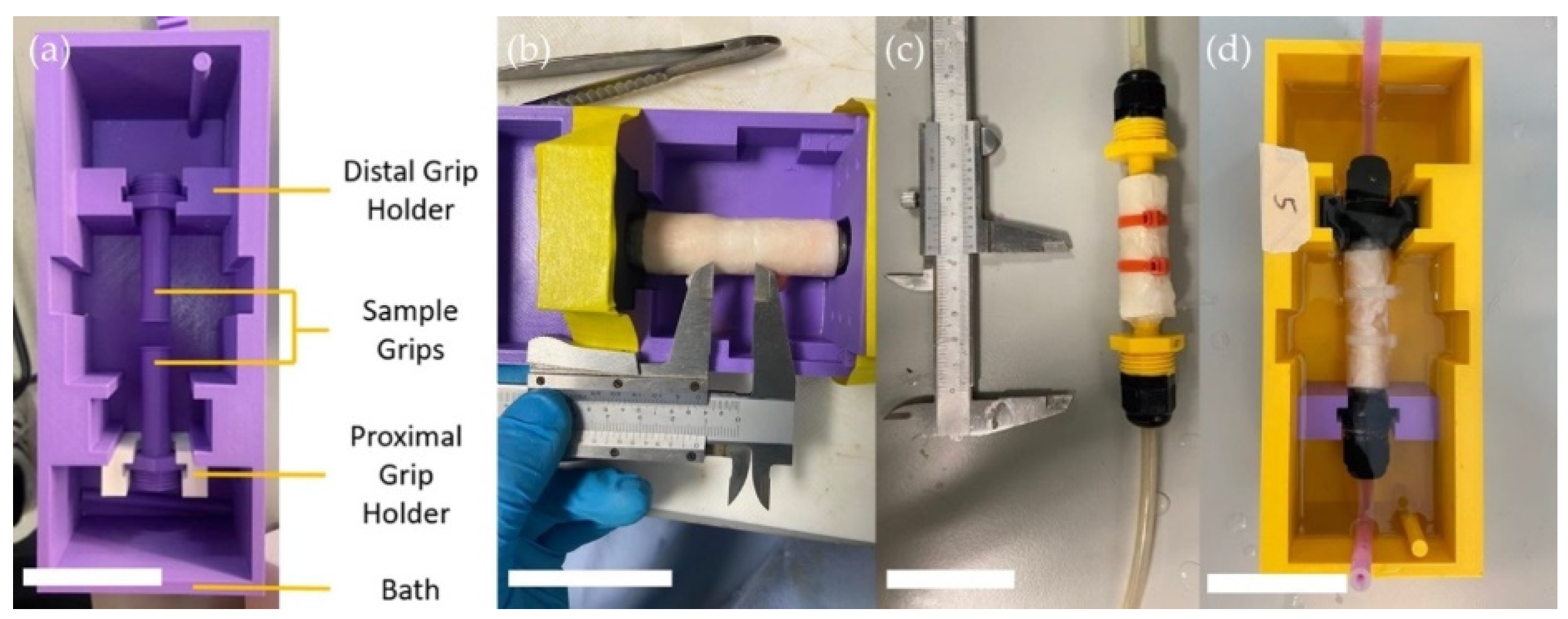
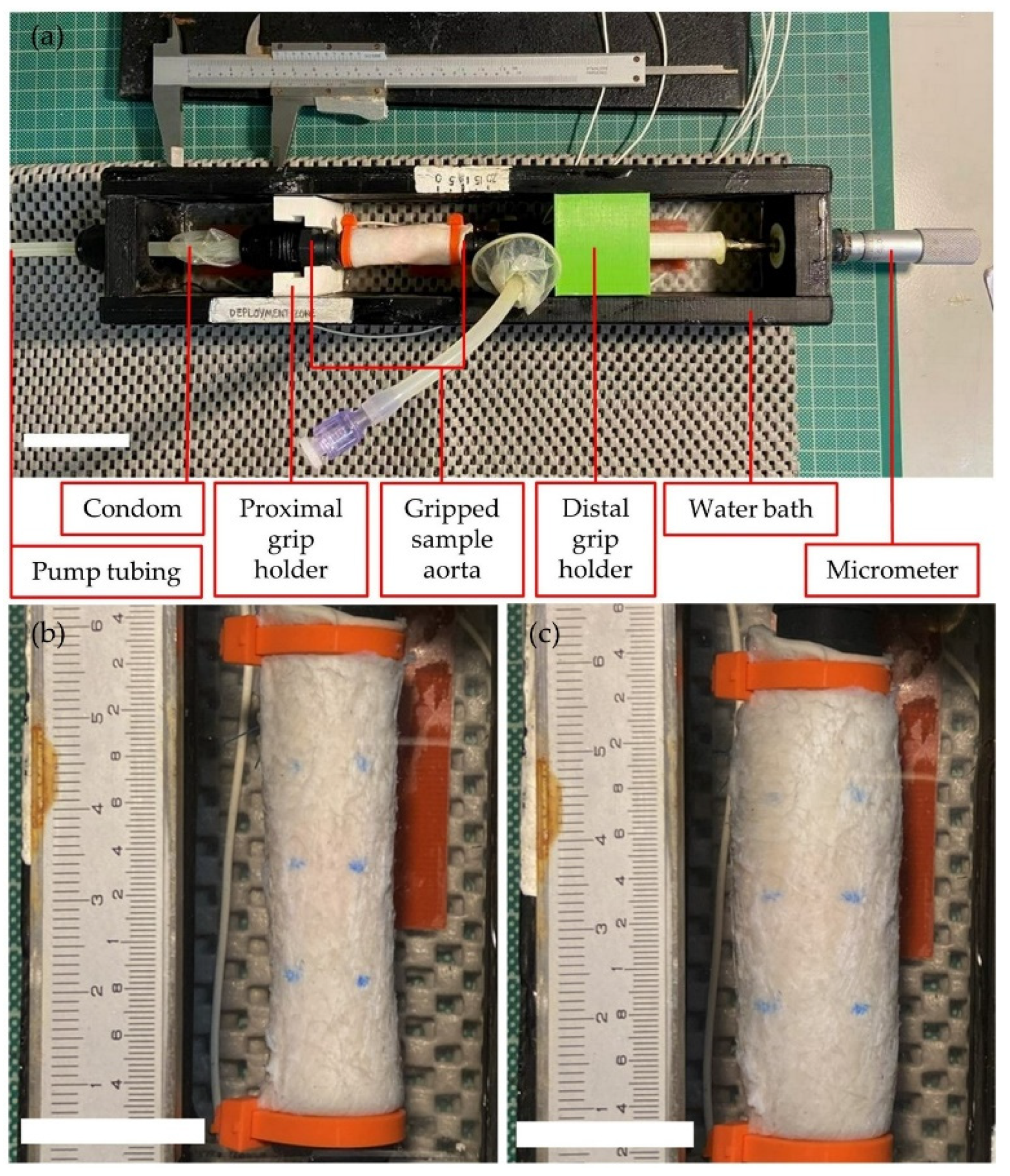
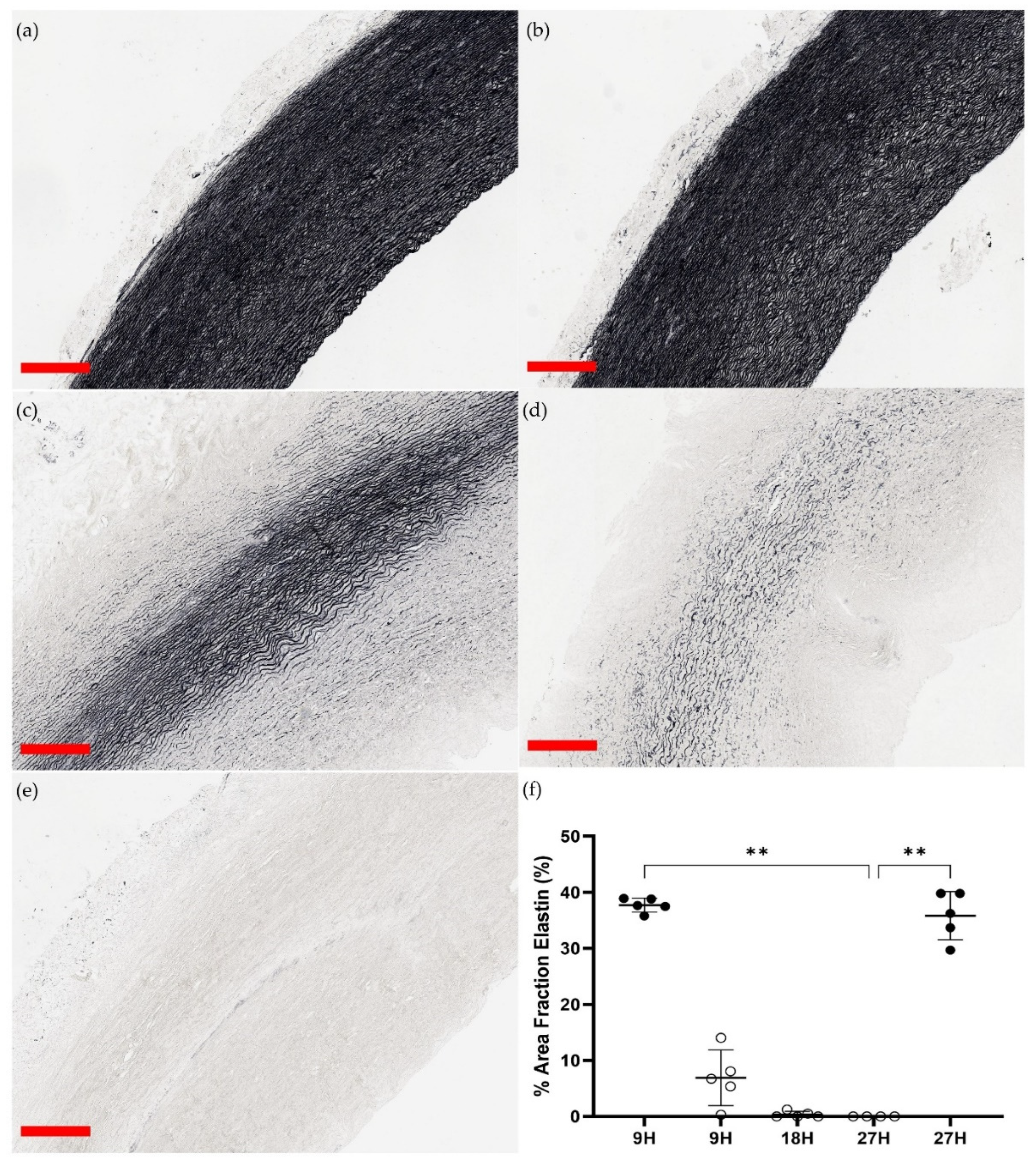
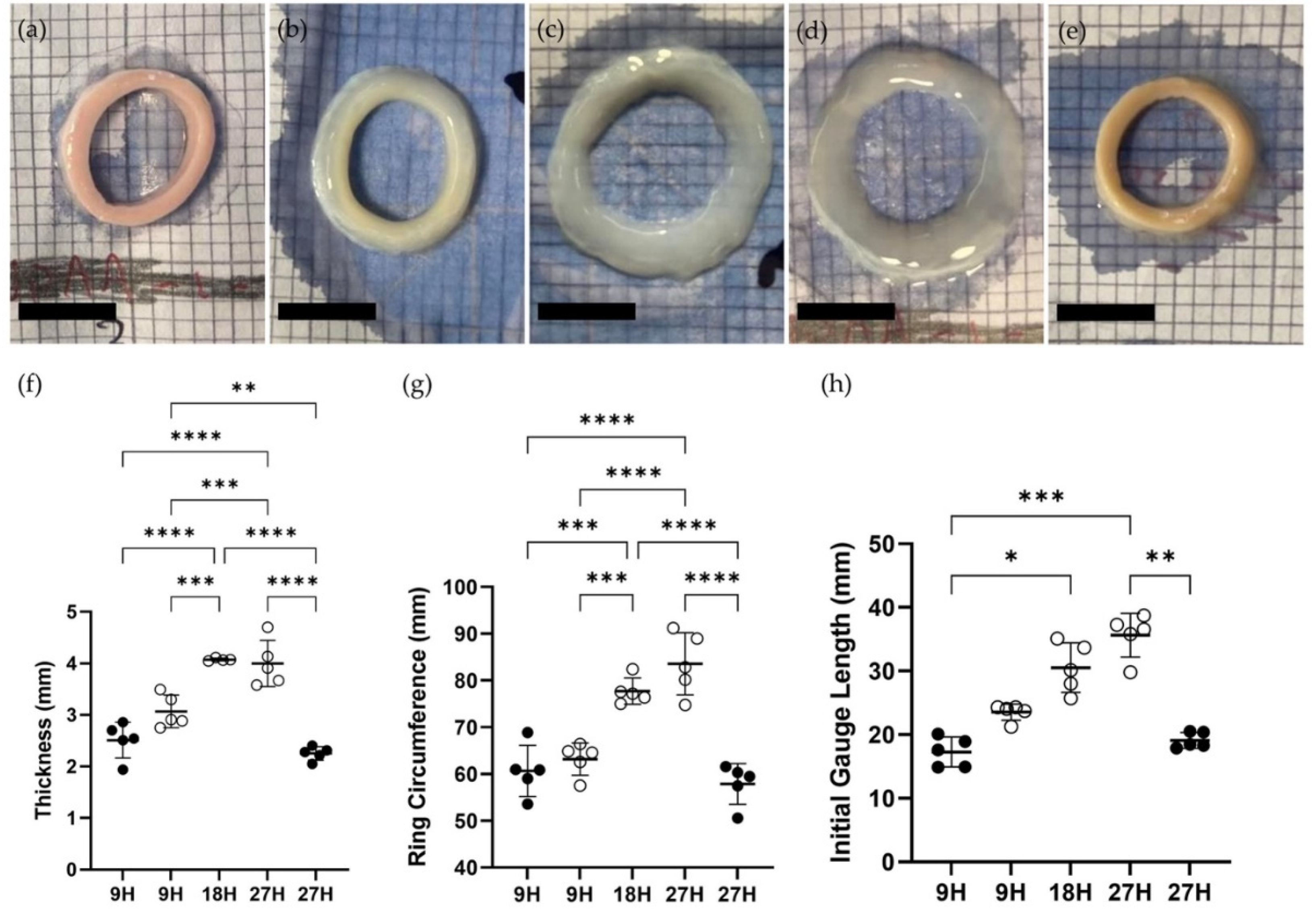
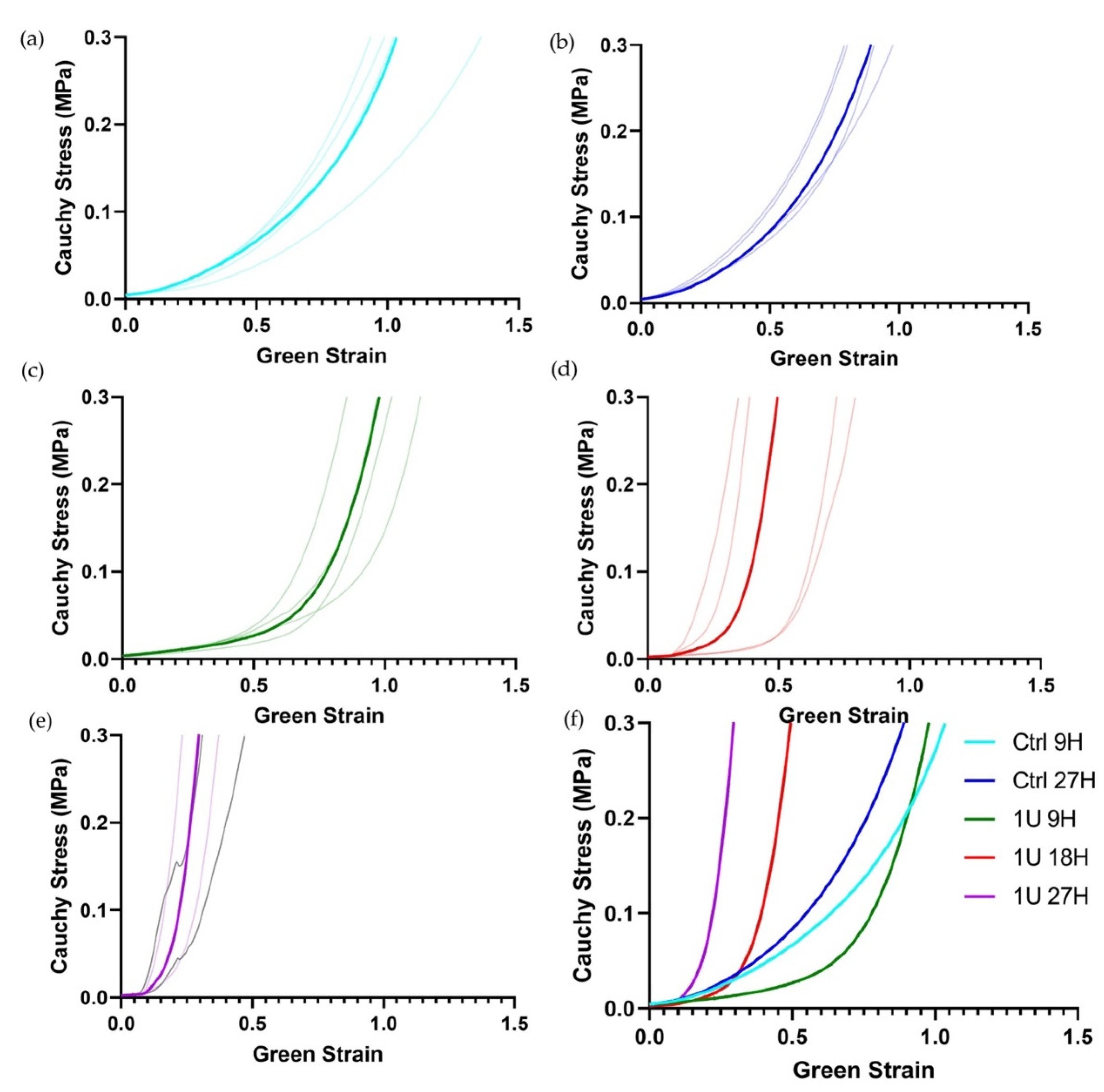
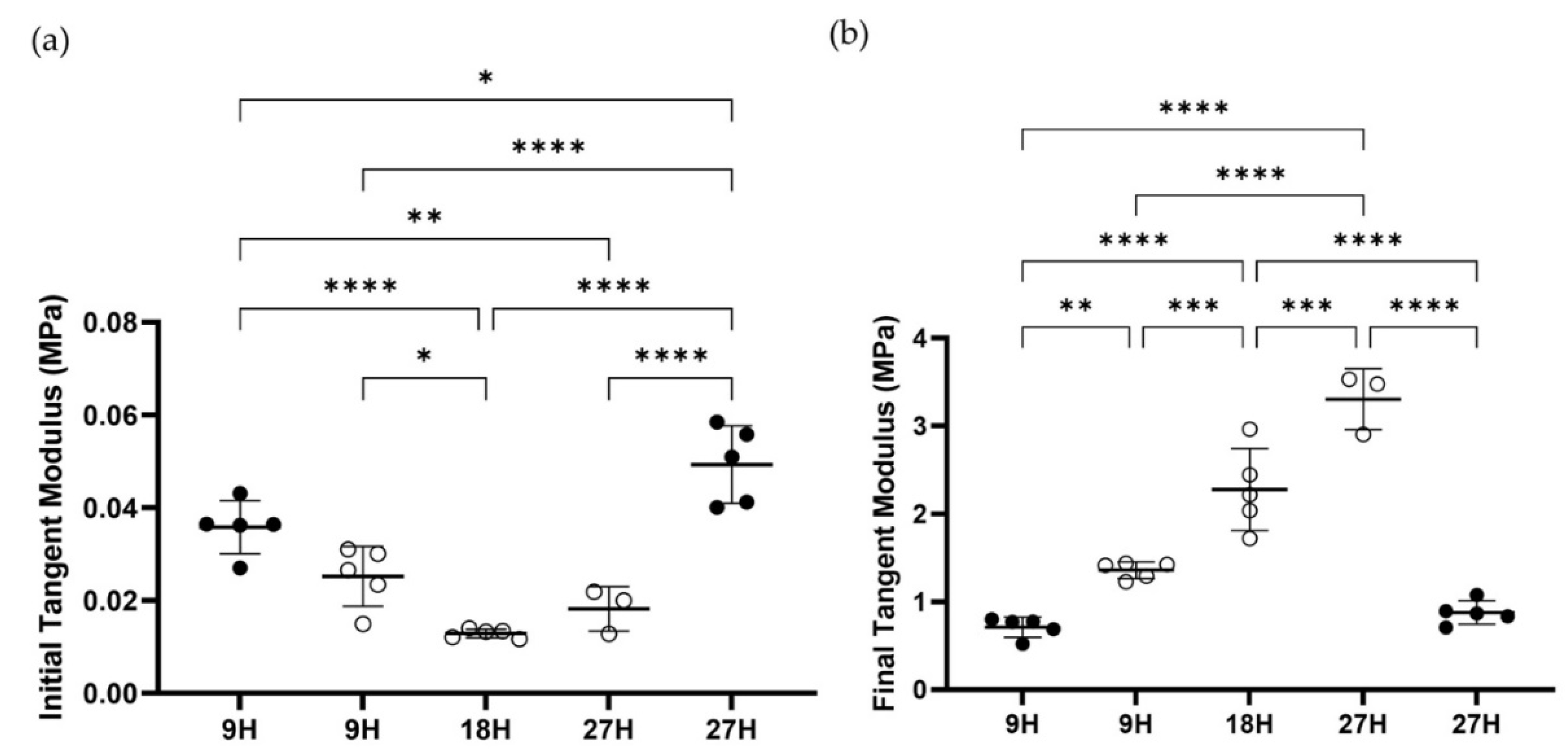
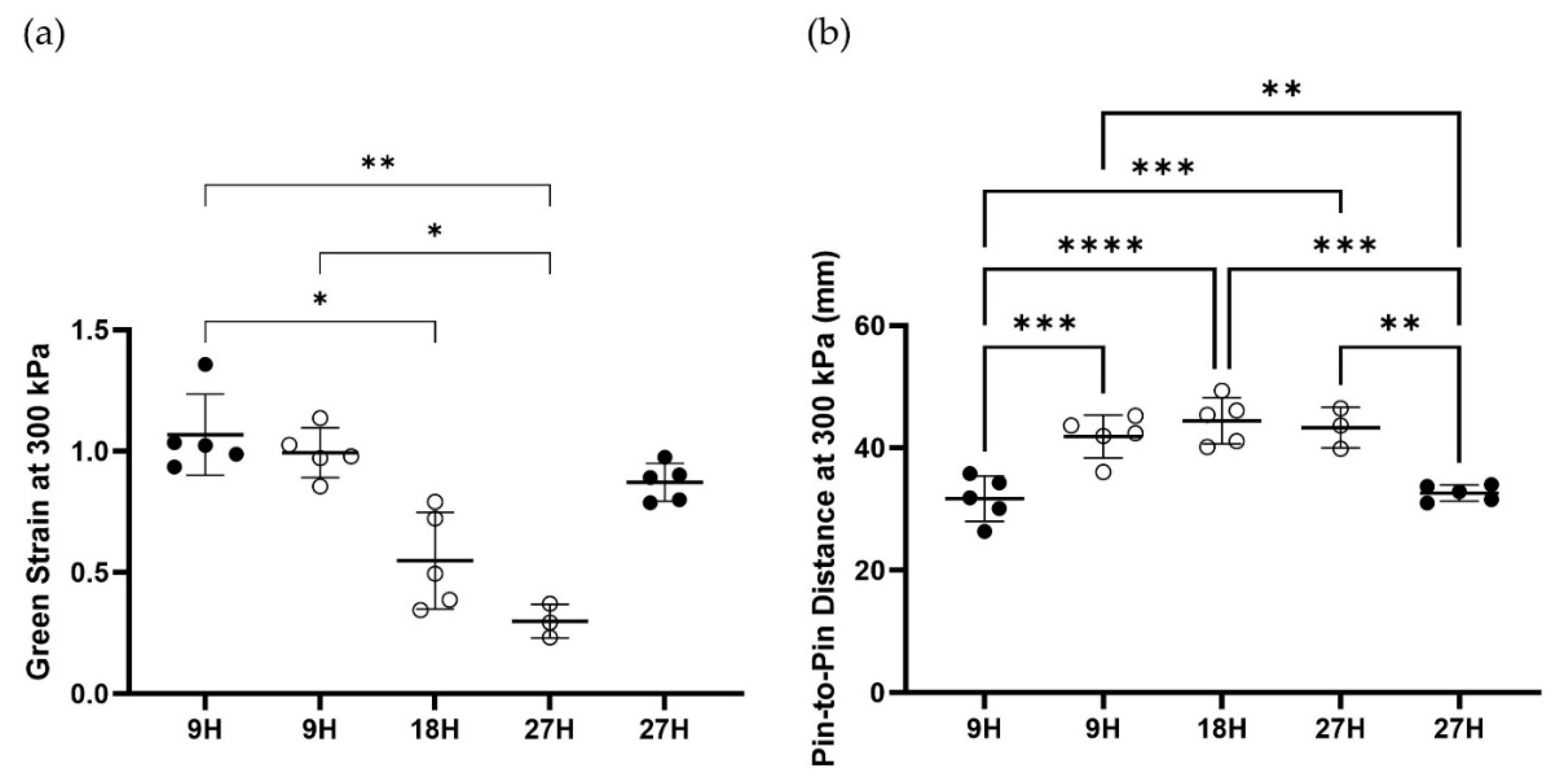
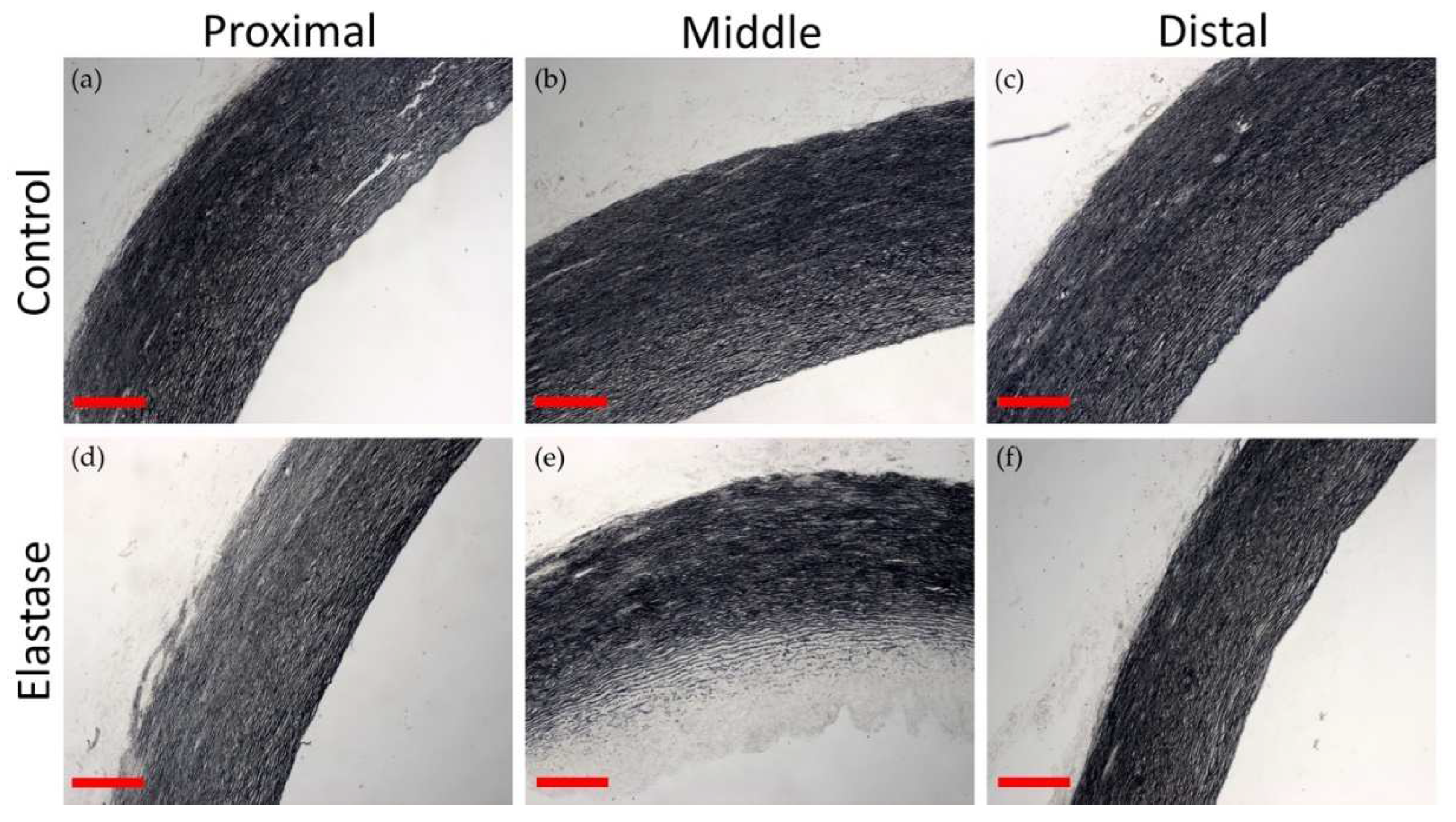
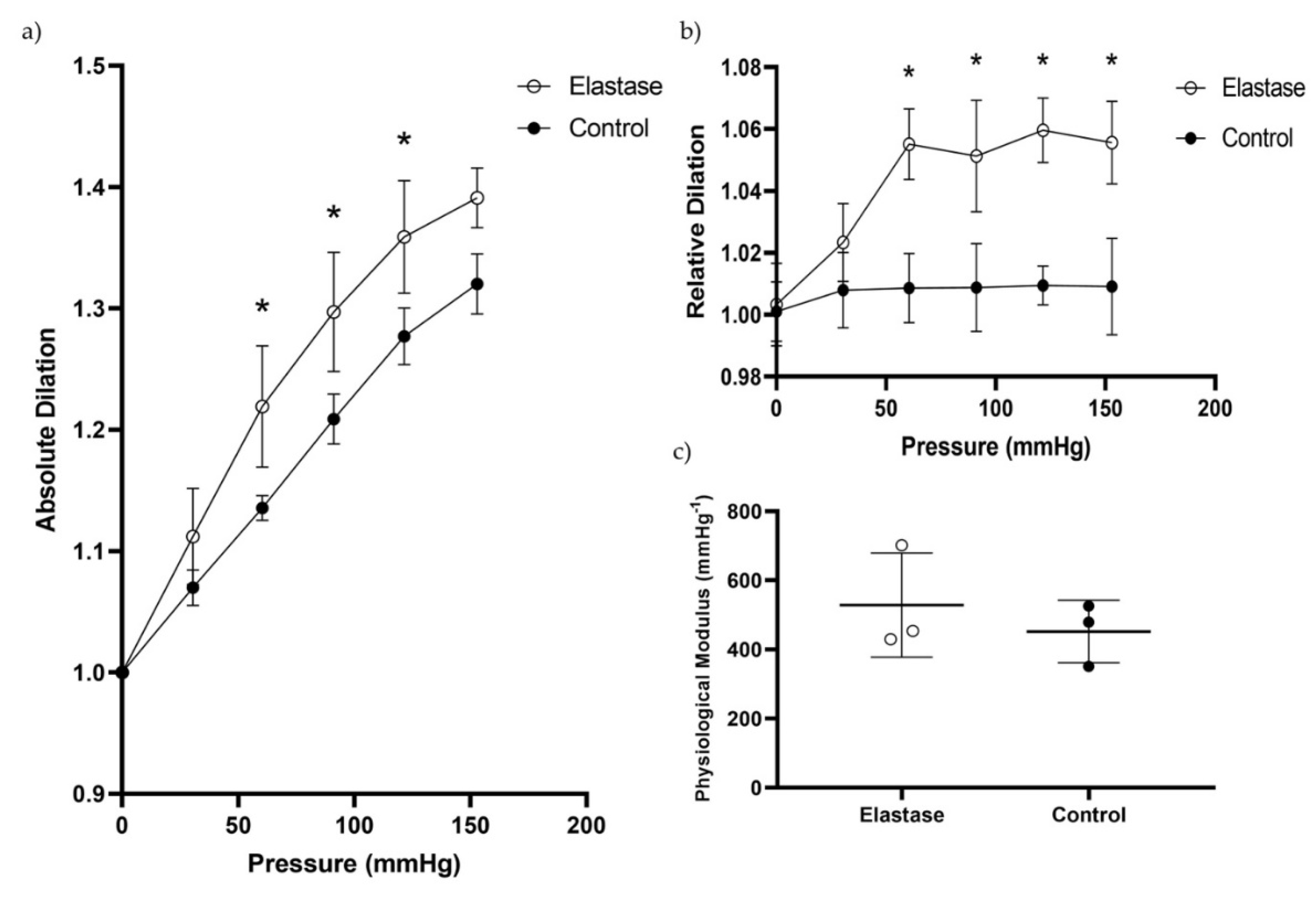
| Aortic sample | Treatment | Elastase concentration [U/ml] |
Incubation time [hours] |
N [pigs] |
n [rings/pig] |
|---|---|---|---|---|---|
| 2 mm ring | Control | 0 | 9 | 5 | 5 |
| 2 mm ring | Elastase | 1 | 9 | 5 | 5 |
| 2 mm ring | Elastase | 1 | 18 | 5 | 5 |
| 2 mm ring | Elastase | 1 | 27 | 5 | 5 |
| 2 mm ring | Control | 0 | 27 | 5 | 5 |
| 6 cm segment | Control | 0 | 9 | 3 | 3 |
| 6 cm segment | Elastase | 1 | 9 | 3 | 3 |
Disclaimer/Publisher’s Note: The statements, opinions and data contained in all publications are solely those of the individual author(s) and contributor(s) and not of MDPI and/or the editor(s). MDPI and/or the editor(s) disclaim responsibility for any injury to people or property resulting from any ideas, methods, instructions or products referred to in the content. |
© 2023 by the authors. Licensee MDPI, Basel, Switzerland. This article is an open access article distributed under the terms and conditions of the Creative Commons Attribution (CC BY) license (https://creativecommons.org/licenses/by/4.0/).





